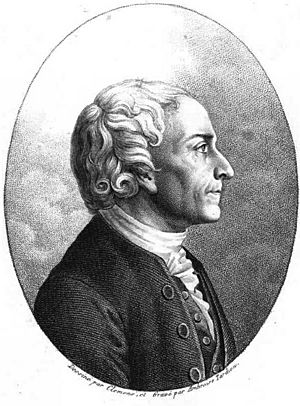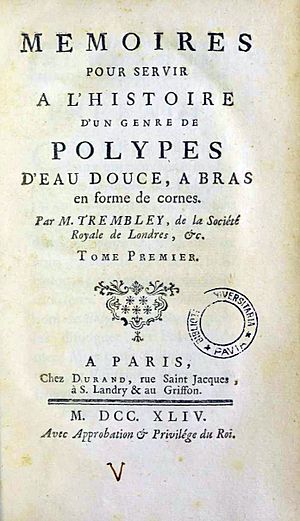Abraham Trembley facts for kids
Quick facts for kids
Abraham Trembley
|
|
|---|---|

Abraham Trembley
|
|
| Born | 3 September 1710 |
| Died | 12 May 1784 (aged 73) |
| Nationality | Genevan |
| Known for | hydra (genus) |
| Awards | Copley Medal, 1743 |
| Scientific career | |
| Fields | Naturalist |
Abraham Trembley (born September 3, 1710 – died May 12, 1784) was a famous Genevan naturalist. A naturalist is a scientist who studies nature, including plants and animals. Trembley is most famous for being the first person to study tiny freshwater animals called hydra.
He was also one of the first scientists to use experiments in zoology, which is the study of animals. Because of his excellent experimental skills, some people call him the "father of biology" (the study of all living things). He also wrote about religion and good behavior.
Biography of Abraham Trembley
Trembley was born into a family of officers in Geneva, which was then a republic. He was the uncle of another famous naturalist, Charles Bonnet. They often wrote letters to each other. He was also connected to other important scientists like René-Antoine Ferchault de Réaumur and Lazzaro Spallanzani.
Trembley worked as a teacher for the two young sons of Count Willem Bentinck van Rhoon. The Count was an important Dutch politician. While teaching the boys, Trembley would often take them fishing in ponds. It was during these lessons that he made his amazing discovery about the hydra. He found out that these tiny creatures could regrow parts of their bodies! These lessons happened at the Count's summer home, Sorgvliet, near The Hague in the Netherlands.
Drawings of Trembley's experiments with the children were made by an artist named Cornelis Pronk. These drawings are still kept in archives in The Hague today.
Trembley's Work on Hydra
When Trembley first found the hydra, he thought he had discovered a brand new animal. However, another scientist named Leeuwenhoek had actually written about hydra earlier, in 1702. Leeuwenhoek called them "animalculum," meaning "tiny animals." He had described how they reproduce by "budding" (a new hydra growing off the side of an old one). He also noted how their tentacles could shrink and stretch, and that they had stinging cells.
Trembley published his important findings in a book in 1744. Its title was Mémoires pour servir à l'histoire d'un genre de polypes d'eau douce, which means "Memoirs to serve the history of a type of freshwater polyp." The book included some of Pronk's detailed drawings.
His discoveries were so important that he became a member of the famous Royal Society in London. He also became a correspondent member of the académie des sciences in France. In 1743, he received the Copley medal, a very important science award.
Some people believe that Trembley was the first to study stem cells, even though he didn't use that name. Stem cells are special cells that can turn into different types of cells. Trembley definitely noticed the hydra's amazing ability to regrow lost body parts. This ability is linked to what we now call stem cells.
Works






